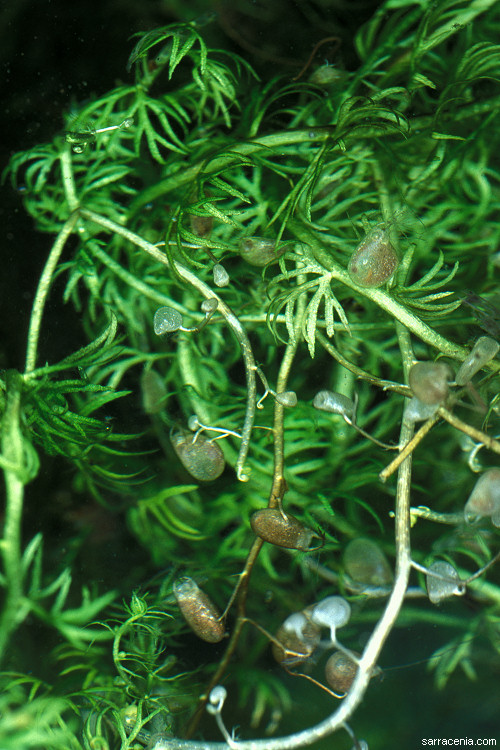
This was so annoying!
"Great, honey, you're
right, you found another species. Good for you."
Man, she found EVERYTHING before I did! Not fair!
The plant she had found was clearly either Utricularia intermedia or
Utricularia ochroleuca. We had found both these species
on previous trips to the lake, so we knew they could be found somewhere.
These two species are very similar, but
can be distinguished from
Utricularia macrorhiza and U. minor by the following
characteristics:
1: They are almost always growing in water only a few cm to
several tens of cm deep, and established plants are well intermixed in the
muck and vegetation. This is like U. minor, only more so.
2: They have small, palmately divided leaves that are divided into about
20 or fewer ultimate leaf tips.
3: The shoots are strongly divided into two types. The first type
is green, leafy, and bears no (or maybe a very few) bladders, the second
type is white or translucent, and is festooned with bladders. The green
shoots are horizontal, near the water's surface. The bladder-bearing
shoots descend into the muck--these are the shoots that "root"
the plants. (I have "root" in quotes because these shoots are
not roots at all, but just act like them.)
4: The terminal leaflet tips are flattened, and not capillary).
5: Viewed under a microscope, the terminal leaflet segments have
tiny needlelike hairs (setulae) on the margins and on the
leaf tip. Verify this carefully with a hand lens or dissecting scope.
Notice in the photograph above how there are green leafy shoots mostly
near the top of the photograph, and white-brown descending bladder-bearing
shoots near the center of the photograph? That is what I mean in point 3
above. These plants were temporarily put into a little aquarium to
photograph them, which is why the plants are a little disheveled. In the
wild, those leafy shoots really stay right at the water surface, while the
bladder-bearing shoots descend downwards.
Characters 3-5 above are reliable for all Utricularia intermedia and
Utricularia ochroleuca plants. This species can also
easily be identified by its flowers,
or by the nature of the
"quadrifid glands" in the bladder.